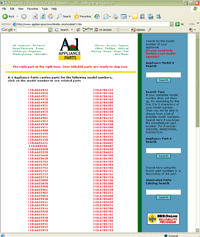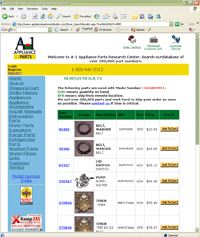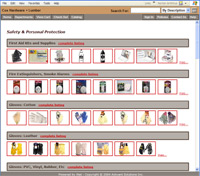Automated HTML Page Production
When web pages need to communicate information from a database, it is common to build the pages dynamically, on the fly. Sometimes it makes sense to build static pages from database-stored information.
Reasons to Build Static Pages:
- To control page-specific content in support of search engine optimization [SEO]
- Automation to produce static pages can be cheaper in some cases than programming dynamically-built pages
- Puts less of a load on the web server to deliver the pages to the browser
- Minimize time for page to be displayed/downloaded to the user
We can go either way: static or dynamic. We consider what will be best to reduce costs
and achieve the client’s goals for both marketing and operations.
Following are some examples of projects we did involving automated production
of static html pages.
Gallery of Automated HTML-Page
Production Projects
|
Rental Pages
Stoughton Lumber
part way down the
"All Rentals" Page

|
|
| each run: |
4 html pages covering
382 rental items |
| page size: |
720 pi wide |
| database: |
Excel database imported
into Access |
| final media: |
html
|
| frequency: |
at will |
|
|
| site: |
www.stoughton-lumber.com |
|
 A PatternStream publishing machine delivers an html page for each group of rentals: contractor, homeowner, party, and new. Stoughton Lumber has 382+ rental units. These pages allow users to see what is available. Then if desired, the user can fill out a rental form online to reserve an item. In this case, Active Lightning used the automation to save labor costs (the client does not own PatternStream or the publishing machine). A PatternStream publishing machine delivers an html page for each group of rentals: contractor, homeowner, party, and new. Stoughton Lumber has 382+ rental units. These pages allow users to see what is available. Then if desired, the user can fill out a rental form online to reserve an item. In this case, Active Lightning used the automation to save labor costs (the client does not own PatternStream or the publishing machine).
|
|
|
|
Index Pages to Document Appliance Models and Parts
A-1 Appliance Parts
|
One of 741 Model Pages

Search Results

|
|
| each run: |
index for all pages,
741 html pages, 100 models/pg |
| page size: |
780 pi wide |
| database: |
SQL Server database that drives
the client's ecommerce ASP.NET
web application |
| final media: |
html
|
| frequency: |
at will |
|
|
| site: www.appliancepartsworldwide.com |
| Accomplished automation with programming (not PatternStream). Each page lists 49 links. Each model hyperlink goes to a Results page with all the parts listed for that model.
These index pages get indexed by the search engines and help natural search users to find models and parts on the AppliancePartsWorldwide.com website.
|
|
|
|
Department Pages for Virtual Hardware Store
Cox Hardware + Lumber
top of page for Safety Dept
in Virtual Hardware Store

|
|
| each run: |
13 html pages, 1 for each dept. |
| page size: |
720 pi wide |
| database: |
Activant Eagle database (runs on a UNIX server) and Microsoft Access |
| final media: |
html
|
| frequency: |
at will |
|
|
| site: |
www.coxhardware.com |
 A PatternStream publishing machine delivers an html page for each department. Products in each department are grouped by classes, so each of these pages displays a list of the department's classes with a sample of product images that identify each class. This enables visitors to identify each class by images, not solely by text. A PatternStream publishing machine delivers an html page for each department. Products in each department are grouped by classes, so each of these pages displays a list of the department's classes with a sample of product images that identify each class. This enables visitors to identify each class by images, not solely by text.
|
|
|




